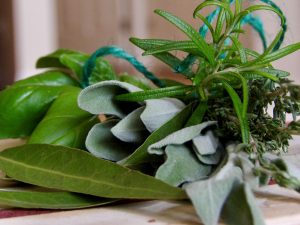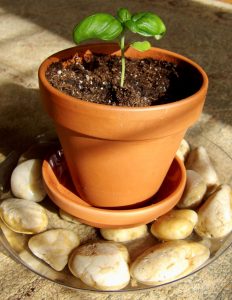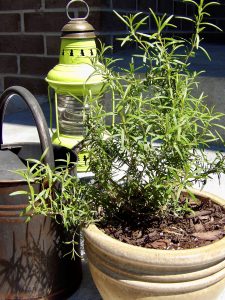In the Garden
By Claire Leduc
Bring greenery into your home for winter

Fall is in the air. The days are getting shorter, and nature is responding by preparing for its long dormant period. Some of us turn to indoor plants to inject a bit of greenery into our homes. You may even have thought of growing edible plants indoors. Have you ever tried to create a small indoor herb garden? A small collection of herbs requires minimal space and can be managed easily.
Best herbs for indoors
Some herbs adapt better than others to indoor conditions. The following list includes some that do well indoors if given the extra care each one requires and provide a regular supply of fresh herbs.
Bay laurel makes a beautiful indoor plant. It tends to be larger than most herbs, but it will reward you with flavourful leaves for stews and soup. Place it somewhere that has good air circulation and be sure not to crowd it with other plants. Bay laurel does best in soil enriched with organic material and very good drainage.
Rosemary, thyme, oregano, and sage are good options for indoors. All of them prefer a fast draining soil; adding a bit of vermiculite or sand to potting soil helps. Small clumps or cuttings taken from an outdoor plant can be rooted in moist vermiculite. Sage likes a slightly more acidic soil, so adding some peat moss to the mix increases the chance of success. All of these plants thrive in hot weather, but with lower light conditions inside a house, they do better in a room that is slightly cooler (15-17 degrees Celsius)

Basil is a great herb if you accept that it is short-lived in an indoor environment. Contrary to rosemary and others, it prefers a rich soil, constant moisture, and a warmer room (20 degrees Celsius).The best way to keep a constant supply of fresh basil leaves is to plant seeds regularly or to start new plants from cuttings rooted in water. If you buy a grocery store plant, you can separate the many baby plants crowded together in the small container they come in. Growing each one on its own can extend its life. Keep them away from cold windows. Basil particularly resents being cold!
Parsley is a very popular herb. It is tempting to dig a small plant from the garden and bring it in, but it may quickly bolt into flowers when brought indoors. It is preferable to start from seed, but be patient, as parsley seeds take a long time to germinate, and require constant moisture. Once you have plants, grow them in a rich potting soil. Parsley requires fewer hours of sunlight (four to five hours a day) than most other herbs.
Tips for success If you plan to bring outdoor herbs inside, it is a good idea to prepare them early for the transition to their new indoor home. Pot the small clumps of herbs you plan to bring in the house, and bring them in before the overnight temperatures dip below 10 degrees Celsius. This avoids the stress of a drastic change in temperature. The last step before the big move is to soak the potted herbs in a pail of water for eight to 10 hours to get rid of any unwanted insects. Inspect the tops and bottoms of leaves and spray them as well, if necessary.
Herbs require light, lots of light! Many originate in the Mediterranean region where the sun shines for many hours a day for much of the year. Even when we grow herbs outdoors in our Ottawa summers, the daylight is very intense compared to what we have inside our homes. Most herbs require a minimum of five to six hours of direct sunlight in a south- or southwest-facing window; otherwise, they grow leggy and gradually perish. If you don’t have a sunny window, you can supplement with a full spectrum grow light, which has become much more economical to purchase and run. It can be left on for 12 to 14 hours a day, which would correspond to five to six hours of outdoor sunlight.
Once settled inside, your herb garden requires a fairly simple care routine. Make sure you water only when the top inch of soil is dry, but water generously, to encourage deeper roots. Once the water has drained, get rid of any excess from the saucer — most herbs dislike having“ wet feet. ”Leaves turning yellow may be a sign of too much water. Start fertilizing only in February when the days start to get longer.

Herbs grow at a much slower rate indoors. For this reason, it is best to not cut more than 10 per cent of the plant at one time. When harvesting, cut the top leaves that tend to be more tender and flavourful, except for bay laurel, where the oldest leaves have the most flavour. Harvesting on a regular basis keeps the plants healthy and bushy. Lastly, your herb garden should be kept away from direct sources of heat, cold drafts, and freezing windows.
By following these guidelines, hopefully you will be able to enjoy healthy plants all winter. Adding fresh herbs to dishes enhances their aroma and taste in a way that dry herbs can’t quite match. When warmer weather returns, it will be time to prepare your plants for another transition, to the great outdoors. A few weeks before the last frost, begin this transition by putting them outside for an hour the first day, and add an hour each day until they can stay outdoors full-time.
Claire Leduc has been gardening for over 25 years, both at a cottage and on a suburban lot in Ottawa. She volunteers with the Master Gardeners of Ottawa Carleton as a way to continue learning, and to share her love of gardening.
Limiting stress
Plants suffer from stress too. Bringing herbs indoors where we have heating systems, dry air, and limited natural light is stressful. The more we mimic the outdoors, the better they do. Ambient humidity is one of the factors we can improve upon. When grouped together (to be avoided with bay laurel), they create their own humid environment by transpiration. If your house is very dry, you can improve the situation further by putting your plant’s pot and saucer over a larger saucer filled with rocks and water. The gradual evaporation provides extra humidity that compensates for the dry air.






